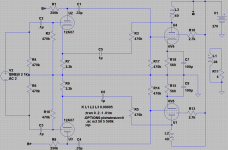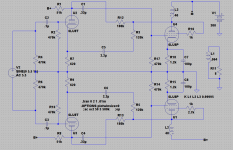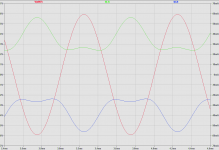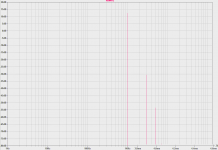If you put a couple of 4 meg. resistors from output plate to driver plate (top and bottom) for some weak "Shunt Schade" N Fdbk, in addition to the existing driver cathode N Fdbk, does that 3rd harmonic increase or decrease? (the extra plate loading on the driver will reduce the loop gain for the driver cathode N Fdbk, so we are not talking about just overall increased N Fdbk)
Testing to see if the two kinds of N Fdbk have opposite residual dist effects. (and if so, then maybe one can find a 3rd H null) (the individual output tube 1st order, residual dist. showing up as 3rd H in P-P)
What I think might be happening (assuming some cancellation) is that driver CFB lets the driver curvature dominate (if sufficiently strong loop gain), while "shunt Schade" lets the output tube curvature dominate. Finding the right mix of the two N Fdbks might find a null point. (the two being relatively phase inverted)
Getting a 3rd harmonic null effect (using the two types of local N Fdbk) may work best for a class aB biased output stage (and so for most practical amplifiers), since a class A P-P output stage already nulls the curvature between the two output tubes.
Class B operation (of class aB overall), with the two types of N Fdbk, allows nulling -each- output tube's curvature against the driver tube's curvature. But this -might- still be helpful for a class A P-P output, only testing would tell.
I also wonder if the Citation II, with its two "local" N Fdbk loops, is doing the same kind of null, but in a little different mode. After all, two N Fdbks to the same point cannot both be satisfied, so some kind of "tuned" mix has to result. I'm sure they tweaked away at the two N Fdbk resistor sets until they satisfied some kind of criteria. They used output plate to driver grid (equivalent to plate to cathode except input Z) making the driver stage dominant, and then they put "shunt Schade" around the driver so its curvature was reduced to just the right amount to null the output tube curvature. Same result.
Testing to see if the two kinds of N Fdbk have opposite residual dist effects. (and if so, then maybe one can find a 3rd H null) (the individual output tube 1st order, residual dist. showing up as 3rd H in P-P)
What I think might be happening (assuming some cancellation) is that driver CFB lets the driver curvature dominate (if sufficiently strong loop gain), while "shunt Schade" lets the output tube curvature dominate. Finding the right mix of the two N Fdbks might find a null point. (the two being relatively phase inverted)
Getting a 3rd harmonic null effect (using the two types of local N Fdbk) may work best for a class aB biased output stage (and so for most practical amplifiers), since a class A P-P output stage already nulls the curvature between the two output tubes.
Class B operation (of class aB overall), with the two types of N Fdbk, allows nulling -each- output tube's curvature against the driver tube's curvature. But this -might- still be helpful for a class A P-P output, only testing would tell.
I also wonder if the Citation II, with its two "local" N Fdbk loops, is doing the same kind of null, but in a little different mode. After all, two N Fdbks to the same point cannot both be satisfied, so some kind of "tuned" mix has to result. I'm sure they tweaked away at the two N Fdbk resistor sets until they satisfied some kind of criteria. They used output plate to driver grid (equivalent to plate to cathode except input Z) making the driver stage dominant, and then they put "shunt Schade" around the driver so its curvature was reduced to just the right amount to null the output tube curvature. Same result.
Don, you should not think about static "harmonic content" equalization; it can be done pretty well by a global loop only; rather, think about what happens when the amp is being overdriven, how it affects stages, how it increases distortions, what kind of distortions, how inaudible they are. It is what for I use nested feedbacks, to get both very low intermods before clipping, but still soft behaviour when clipping happens. I.e. all the way in dynamics, when listening to the music that has a complex envelope and a huge frequency band.
- Status
- This old topic is closed. If you want to reopen this topic, contact a moderator using the "Report Post" button.



